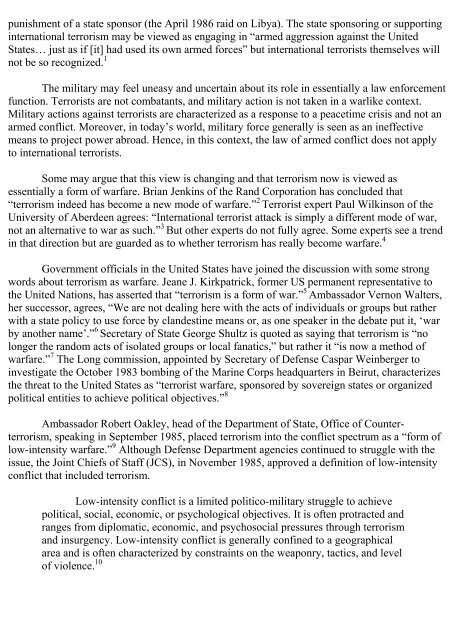Legitimate use of military force against state-sponsored - Air University
Legitimate use of military force against state-sponsored - Air University
Legitimate use of military force against state-sponsored - Air University
You also want an ePaper? Increase the reach of your titles
YUMPU automatically turns print PDFs into web optimized ePapers that Google loves.
punishment <strong>of</strong> a <strong>state</strong> sponsor (the April 1986 raid on Libya). The <strong>state</strong> sponsoring or supporting<br />
international terrorism may be viewed as engaging in “armed aggression <strong>against</strong> the United<br />
States… just as if [it] had <strong>use</strong>d its own armed <strong>force</strong>s” but international terrorists themselves will<br />
not be so recognized. 1<br />
The <strong>military</strong> may feel uneasy and uncertain about its role in essentially a law en<strong>force</strong>ment<br />
function. Terrorists are not combatants, and <strong>military</strong> action is not taken in a warlike context.<br />
Military actions <strong>against</strong> terrorists are characterized as a response to a peacetime crisis and not an<br />
armed conflict. Moreover, in today’s world, <strong>military</strong> <strong>force</strong> generally is seen as an ineffective<br />
means to project power abroad. Hence, in this context, the law <strong>of</strong> armed conflict does not apply<br />
to international terrorists.<br />
Some may argue that this view is changing and that terrorism now is viewed as<br />
essentially a form <strong>of</strong> warfare. Brian Jenkins <strong>of</strong> the Rand Corporation has concluded that<br />
“terrorism indeed has become a new mode <strong>of</strong> warfare.” 2 Terrorist expert Paul Wilkinson <strong>of</strong> the<br />
<strong>University</strong> <strong>of</strong> Aberdeen agrees: “International terrorist attack is simply a different mode <strong>of</strong> war,<br />
not an alternative to war as such.” 3 But other experts do not fully agree. Some experts see a trend<br />
in that direction but are guarded as to whether terrorism has really become warfare. 4<br />
Government <strong>of</strong>ficials in the United States have joined the discussion with some strong<br />
words about terrorism as warfare. Jeane J. Kirkpatrick, former US permanent representative to<br />
the United Nations, has asserted that “terrorism is a form <strong>of</strong> war.” 5 Ambassador Vernon Walters,<br />
her successor, agrees, “We are not dealing here with the acts <strong>of</strong> individuals or groups but rather<br />
with a <strong>state</strong> policy to <strong>use</strong> <strong>force</strong> by clandestine means or, as one speaker in the debate put it, ‘war<br />
by another name’.” 6 Secretary <strong>of</strong> State George Shultz is quoted as saying that terrorism is “no<br />
longer the random acts <strong>of</strong> isolated groups or local fanatics,” but rather it “is now a method <strong>of</strong><br />
warfare.” 7 The Long commission, appointed by Secretary <strong>of</strong> Defense Caspar Weinberger to<br />
investigate the October 1983 bombing <strong>of</strong> the Marine Corps headquarters in Beirut, characterizes<br />
the threat to the United States as “terrorist warfare, <strong>sponsored</strong> by sovereign <strong>state</strong>s or organized<br />
political entities to achieve political objectives.” 8<br />
Ambassador Robert Oakley, head <strong>of</strong> the Department <strong>of</strong> State, Office <strong>of</strong> Counterterrorism,<br />
speaking in September 1985, placed terrorism into the conflict spectrum as a “form <strong>of</strong><br />
low-intensity warfare.” 9 Although Defense Department agencies continued to struggle with the<br />
issue, the Joint Chiefs <strong>of</strong> Staff (JCS), in November 1985, approved a definition <strong>of</strong> low-intensity<br />
conflict that included terrorism.<br />
Low-intensity conflict is a limited politico-<strong>military</strong> struggle to achieve<br />
political, social, economic, or psychological objectives. It is <strong>of</strong>ten protracted and<br />
ranges from diplomatic, economic, and psychosocial pressures through terrorism<br />
and insurgency. Low-intensity conflict is generally confined to a geographical<br />
area and is <strong>of</strong>ten characterized by constraints on the weaponry, tactics, and level<br />
<strong>of</strong> violence. 10
















